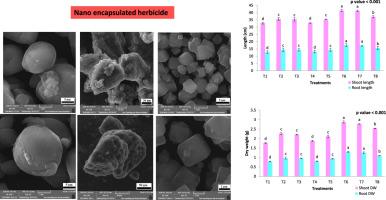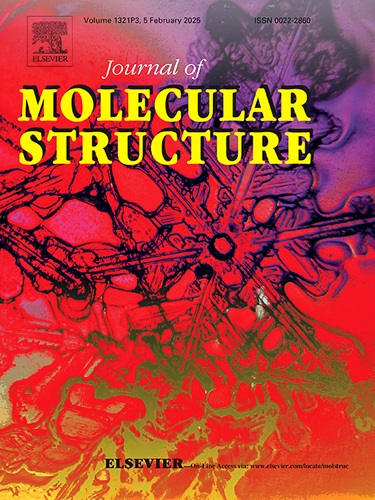包封除草剂的控释制剂可增强除草剂活性,作为农业生态毒性的一种工具
IF 4
2区 化学
Q2 CHEMISTRY, PHYSICAL
引用次数: 0
摘要
本研究涉及合成封装除草剂,以改善除草剂的药效和活性检测,减少对环境的影响。使用粒度分析仪和扫描电子显微镜对沸石、聚己内酯和水溶性聚合物包裹合成的吡嘧磺隆乙酯和丙草胺的粒度和形态进行了表征。在封装的除草剂中,吡嘧磺隆乙酯夹带沸石的直径为 12,950 nm,形态为典型的均匀、规则的立方体结构,除草剂封装效率高达 86%,活性测定结果表明水稻生长更好。它与聚己内酯封装的吡嘧磺隆乙酯相当,后者的直径为 3679 nm,形状不规则。水溶液释放研究表明,用沸石包裹的吡嘧磺隆乙基除草剂具有更好的控释性能,在土壤柱中的沥滤潜力较低。因此,利用沸石、聚己内酯和水溶性聚合物制成的控释除草剂制剂可在目标物种中释放除草剂,并降低土壤中的浸出率,从而作为农业生态毒性的一种工具。本文章由计算机程序翻译,如有差异,请以英文原文为准。

Controlled release formulations of encapsulated herbicide enhances herbicide activity as a tool for agro-ecotoxicity
This study involves the synthesis of encapsulated herbicides to improve herbicide efficacy and activity assays, to reduce their environmental impact. The synthesized pyrazosulfuron ethyl and pretilachlor entrapped with zeolite, polycaprolactone and water-soluble polymer were characterized using a Particle size analyzer and Scanning Electron Microscope to interpret the size and morphology. Among the encapsulated herbicides, pyrazosulfuron ethyl entrapped zeolite shows a 12,950 nm in diameter and a typical morphology of a uniform, regular cubical-like structure, with a higher herbicide encapsulation efficiency of 86 % and activity assay results in better rice growth. It was on par with the pyrazosulfuron ethyl encapsulated with polycaprolactone, which has a 3679 nm diameter and an irregular shape. The Aqueous release studies show the controlled release of encapsulated herbicide, among them pyrazosulfuron ethyl entrapped with zeolite shows better performance with low leaching potential in the soil column. Thus, Controlled release herbicide formulation with zeolite, polycaprolactone and water soluble polymer was used to release herbicide in target species and reduces the leaching potential to the soil which acts as a tool for agroecotoxicity.
求助全文
通过发布文献求助,成功后即可免费获取论文全文。
去求助
来源期刊

Journal of Molecular Structure
化学-物理化学
CiteScore
7.10
自引率
15.80%
发文量
2384
审稿时长
45 days
期刊介绍:
The Journal of Molecular Structure is dedicated to the publication of full-length articles and review papers, providing important new structural information on all types of chemical species including:
• Stable and unstable molecules in all types of environments (vapour, molecular beam, liquid, solution, liquid crystal, solid state, matrix-isolated, surface-absorbed etc.)
• Chemical intermediates
• Molecules in excited states
• Biological molecules
• Polymers.
The methods used may include any combination of spectroscopic and non-spectroscopic techniques, for example:
• Infrared spectroscopy (mid, far, near)
• Raman spectroscopy and non-linear Raman methods (CARS, etc.)
• Electronic absorption spectroscopy
• Optical rotatory dispersion and circular dichroism
• Fluorescence and phosphorescence techniques
• Electron spectroscopies (PES, XPS), EXAFS, etc.
• Microwave spectroscopy
• Electron diffraction
• NMR and ESR spectroscopies
• Mössbauer spectroscopy
• X-ray crystallography
• Charge Density Analyses
• Computational Studies (supplementing experimental methods)
We encourage publications combining theoretical and experimental approaches. The structural insights gained by the studies should be correlated with the properties, activity and/ or reactivity of the molecule under investigation and the relevance of this molecule and its implications should be discussed.
 求助内容:
求助内容: 应助结果提醒方式:
应助结果提醒方式:


